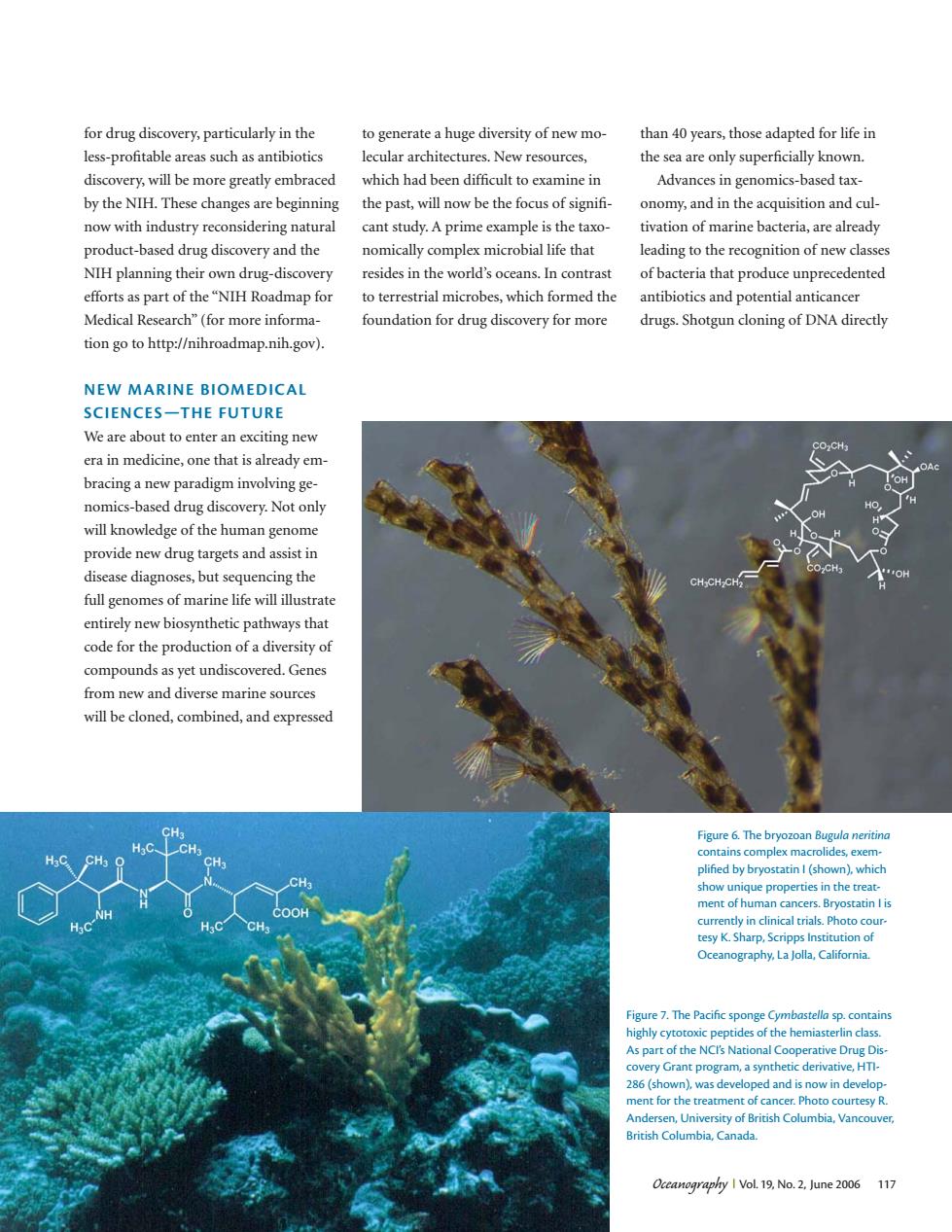正在加载图片...

for drug discovery,particularly in the to generate a huge diversity of new mo- than 40 years,those adapted for life in less-profitable areas such as antibiotics lecular architectures.New resources the sea are only superficially known. discovery,will be more greatly embraced which had been difficult to examine in Advances in genomics-based tax- by the NIH.These changes are beginning the past,will now be the focus of signifi- onomy,and in the acquisition and cul- now with industry reconsidering natural cant study.A prime example is the taxo tivation of marine bacteria,are already product-based drug discovery and the nomically complex microbial life that leading to the recognition of new classes NIH planning their own drug-discover resides in the world's oceans.In contrast of bacteria that produce unprecedented efforts as part of the"NIH Roadmap for to terrestrial microbes,which formed the antibiotics and potential anticancer Medical Research"(for more informa- foundation for drug discovery for more drugs.Shotgun cloning of DNA directly tion go to http://nihroadmap.nih.gov) NEW MARINE BIOMEDICAL SCIENCES-THE FUTURE We are about to enter an exciting new era in medicine,one that is already em bracing a new paradigm involving ge nomics-based drug discovery.Not only will knowledge of the human genome provide new drug targets and assist in discase diagnoses,but sequencing the full genomes of marine life will illustrate entirely new biosynthetic pathways that code for the production of a diversity of compounds as yet undiscovered.Genes from new and diverse marine sources will be cloned,combined,and expressed Figure6The bryozoan Bugula neritina ontains complex ma rolides,exem n)whic ment of human cancers Bryostatin lis anography. nge Cym shown),was de ed and now in develo Andersen,University of British Columbia,Vanco British Columbia.Canada. Oceanography I Vol 19,No..June 2006 117Oceanography Vol. 19, No. 2, June 2006 117 Figure 6. Th e bryozoan Bugula neritina contains complex macrolides, exemplifi ed by bryostatin I (shown), which show unique properties in the treatment of human cancers. Bryostatin I is currently in clinical trials. Photo courtesy K. Sharp, Scripps Institution of Oceanography, La Jolla, California. Figure 7. Th e Pacifi c sponge Cymbastella sp. contains highly cytotoxic peptides of the hemiasterlin class. As part of the NCI’s National Cooperative Drug Discovery Grant program, a synthetic derivative, HTI- 286 (shown), was developed and is now in development for the treatment of cancer. Photo courtesy R. Andersen, University of British Columbia, Vancouver, British Columbia, Canada. for drug discovery, particularly in the less-profi table areas such as antibiotics discovery, will be more greatly embraced by the NIH. These changes are beginning now with industry reconsidering natural product-based drug discovery and the NIH planning their own drug-discovery efforts as part of the “NIH Roadmap for Medical Research” (for more information go to http://nihroadmap.nih.gov). NEW MARINE BIOMEDICAL SCIENCESTHE FUTURE We are about to enter an exciting new era in medicine, one that is already embracing a new paradigm involving genomics-based drug discovery. Not only will knowledge of the human genome provide new drug targets and assist in disease diagnoses, but sequencing the full genomes of marine life will illustrate entirely new biosynthetic pathways that code for the production of a diversity of compounds as yet undiscovered. Genes from new and diverse marine sources will be cloned, combined, and expressed to generate a huge diversity of new molecular architectures. New resources, which had been diffi cult to examine in the past, will now be the focus of signifi - cant study. A prime example is the taxonomically complex microbial life that resides in the world’s oceans. In contrast to terrestrial microbes, which formed the foundation for drug discovery for more than 40 years, those adapted for life in the sea are only superfi cially known. Advances in genomics-based taxonomy, and in the acquisition and cultivation of marine bacteria, are already leading to the recognition of new classes of bacteria that produce unprecedented antibiotics and potential anticancer drugs. Shotgun cloning of DNA directly